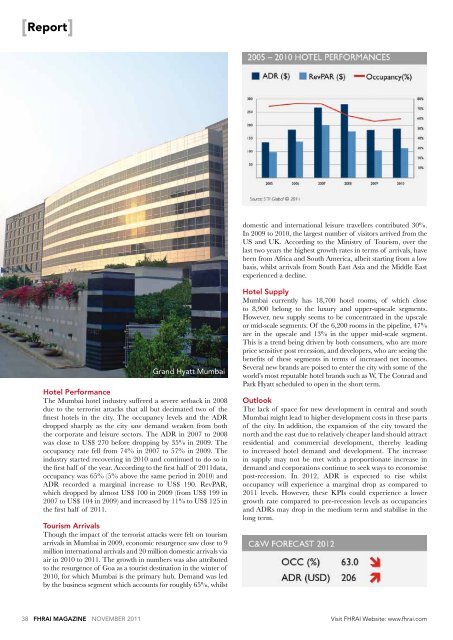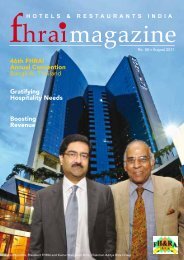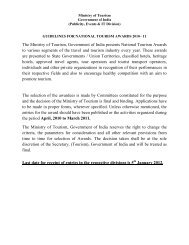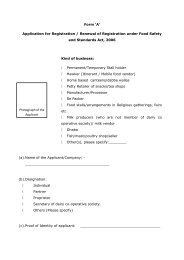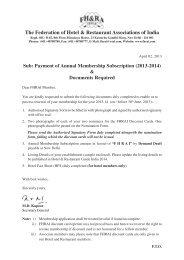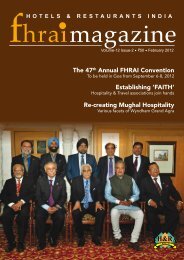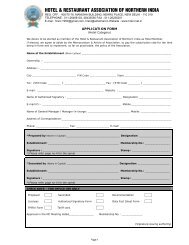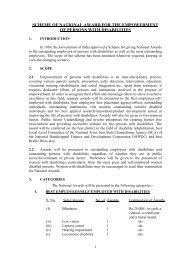FHRAI Magazine - Federation of Hotel and Restaurant Associations ...
FHRAI Magazine - Federation of Hotel and Restaurant Associations ...
FHRAI Magazine - Federation of Hotel and Restaurant Associations ...
Create successful ePaper yourself
Turn your PDF publications into a flip-book with our unique Google optimized e-Paper software.
[ Report ]<br />
domestic <strong>and</strong> international leisure travellers contributed 30%.<br />
In 2009 to 2010, the largest number <strong>of</strong> visitors arrived from the<br />
US <strong>and</strong> UK. According to the Ministry <strong>of</strong> Tourism, over the<br />
last two years the highest growth rates in terms <strong>of</strong> arrivals, have<br />
been from Africa <strong>and</strong> South America, albeit starting from a low<br />
basis, whilst arrivals from South East Asia <strong>and</strong> the Middle East<br />
experienced a decline.<br />
Gr<strong>and</strong> Hyatt Mumbai<br />
<strong>Hotel</strong> Performance<br />
The Mumbai hotel industry suffered a severe setback in 2008<br />
due to the terrorist attacks that all but decimated two <strong>of</strong> the<br />
finest hotels in the city. The occupancy levels <strong>and</strong> the ADR<br />
dropped sharply as the city saw dem<strong>and</strong> weaken from both<br />
the corporate <strong>and</strong> leisure sectors. The ADR in 2007 to 2008<br />
was close to US$ 270 before dropping by 35% in 2009. The<br />
occupancy rate fell from 74% in 2007 to 57% in 2009. The<br />
industry started recovering in 2010 <strong>and</strong> continued to do so in<br />
the first half <strong>of</strong> the year. According to the first half <strong>of</strong> 2011data,<br />
occupancy was 65% (5% above the same period in 2010) <strong>and</strong><br />
ADR recorded a marginal increase to US$ 190. RevPAR,<br />
which dropped by almost US$ 100 in 2009 (from US$ 199 in<br />
2007 to US$ 104 in 2009) <strong>and</strong> increased by 11% to US$ 125 in<br />
the first half <strong>of</strong> 2011.<br />
Tourism Arrivals<br />
Though the impact <strong>of</strong> the terrorist attacks were felt on tourism<br />
arrivals in Mumbai in 2009, economic resurgence saw close to 9<br />
million international arrivals <strong>and</strong> 20 million domestic arrivals via<br />
air in 2010 to 2011. The growth in numbers was also attributed<br />
to the resurgence <strong>of</strong> Goa as a tourist destination in the winter <strong>of</strong><br />
2010, for which Mumbai is the primary hub. Dem<strong>and</strong> was led<br />
by the business segment which accounts for roughly 65%, whilst<br />
<strong>Hotel</strong> Supply<br />
Mumbai currently has 18,700 hotel rooms, <strong>of</strong> which close<br />
to 8,900 belong to the luxury <strong>and</strong> upper-upscale segments.<br />
However, new supply seems to be concentrated in the upscale<br />
or mid-scale segments. Of the 6,200 rooms in the pipeline, 47%<br />
are in the upscale <strong>and</strong> 13% in the upper mid-scale segment.<br />
This is a trend being driven by both consumers, who are more<br />
price sensitive post recession, <strong>and</strong> developers, who are seeing the<br />
benefits <strong>of</strong> these segments in terms <strong>of</strong> increased net incomes.<br />
Several new br<strong>and</strong>s are poised to enter the city with some <strong>of</strong> the<br />
world’s most reputable hotel br<strong>and</strong>s such as W, The Conrad <strong>and</strong><br />
Park Hyatt scheduled to open in the short term.<br />
Outlook<br />
The lack <strong>of</strong> space for new development in central <strong>and</strong> south<br />
Mumbai might lead to higher development costs in these parts<br />
<strong>of</strong> the city. In addition, the expansion <strong>of</strong> the city toward the<br />
north <strong>and</strong> the east due to relatively cheaper l<strong>and</strong> should attract<br />
residential <strong>and</strong> commercial development, thereby leading<br />
to increased hotel dem<strong>and</strong> <strong>and</strong> development. The increase<br />
in supply may not be met with a proportionate increase in<br />
dem<strong>and</strong> <strong>and</strong> corporations continue to seek ways to economise<br />
post-recession. In 2012, ADR is expected to rise whilst<br />
occupancy will experience a marginal drop as compared to<br />
2011 levels. However, these KPIs could experience a lower<br />
growth rate compared to pre-recession levels as occupancies<br />
<strong>and</strong> ADRs may drop in the medium term <strong>and</strong> stabilise in the<br />
long term.<br />
38 <strong>FHRAI</strong> <strong>Magazine</strong> november 2011 Visit <strong>FHRAI</strong> Website: www.fhrai.com


